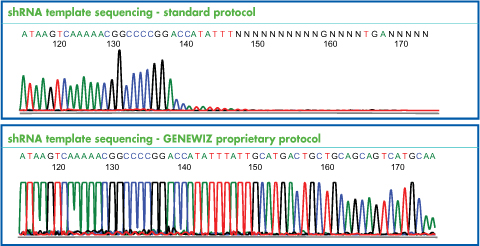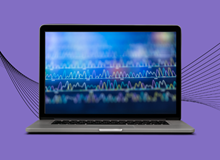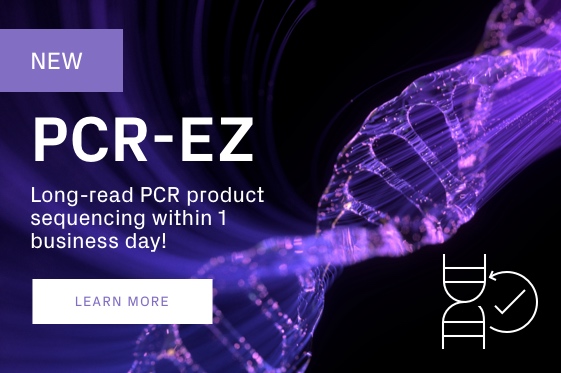Difficult Template Sequencing
Difficult Template sequencing is a proprietary Sanger protocol adept at tackling GC-rich regions, hairpins, and intricate secondary structures, ensuring a success rate more than double that of standard workflows. With GENEWIZ Difficult Template sequencing from Azenta Life Sciences, save at least 1 day in the sequencing process, and streamline your research.
Compatible with various DNA types including PCR products, plasmids, bacterial colonies, and glycerol stocks, our service eliminates the need for additional templates, providing unparalleled convenience and efficiency for your breakthrough projects.
Alternative Protocols for Difficult Templates
Template examples that may benefit from the alternative protocols include:
- GC-rich: A template of > 60% GC content or high GC-content concentrated in a small region
- Hairpin Structures: A sequence containing two inverted repeats, separated by at least three nucleotides
- Repeats: Certain di- or tri-nucleotide repeats
- Motifs causing band compressions: Mainly 5′-YGN1-2AR motifs, (Y: pyrimidine; R: purine; N: any base)
- Bacterial Artificial Chromosomes (BAC): Any construct larger than 50 kb.
Template Examples
Case 1: Small Hairpin RNA (shRNA) Template Sequencing
The small hairpin RNA templates used in RNAi studies frequently present challenges in sequencing such as early termination or ambiguity, caused by the double-stranded or hairpin structures. Our proprietary RNAi Protocol produces superior results for our customers, saving time and cost. For a comparison, see the chromatogram below:

Case 2: Repeat / GC rich Template Sequencing
Repeat/GC-rich templates have special secondary structures and melting temperatures. DNA containing high GC content and hairpin structures are relatively more difficult to denature and very challenging to sequence.
Our proprietary Hairpin and GC-rich protocols produce superior results, with strong signals and uniform peak heights at the GC region.

BAC-end Sequencing for Constructs Greater than 50 kb
Large constructs such as Bacterial Artificial Chromosomes (BACs), cosmids, fosmids, and BACmids, pose a challenge to traditional Sanger sequencing protocols due to the size and interference of the non-target DNA in the template. GENEWIZ’s proprietary BAC protocol to overcome the difficulty of sequencing directly from these large constructs can help deliver greater success and longer read lengths for large constructs compared to the standard protocol.
Please contact our Technical Support team for more information on BAC protocol’s:
Email | Phone (1-877-GENEWIZ (436-3949), Ext. 2) | Live Chat
FEATURES & BENEFITS
GENEWIZ provides our difficult template sequencing service (see above) using modified protocols, developed in-house, specifically for success with difficult templates. Years of use have confirmed that these alternative protocols deliver best-in-class results.
GENEWIZ provides individualized scientific consultation and customized solutions for your specific DNA sequencing needs, through our Technical Support team.
Our Technical Support team, staffed by multiple Ph.D. scientists with a friendly, problem-solving spirit, is available to advise and assist you at no charge Monday – Friday, 8AM – 8PM Eastern. GENEWIZ Technical Support also posts results on Saturdays, so research progress can continue forward over the weekend.
APPLICATIONS

Advanced Technology
GENEWIZ provides our difficult template sequencingservice (see above) using modified protocols,
developed in-house, specifically for success
with difficult templates. Years of use have
confirmed that these alternative protocols
deliver best-in-class results.

Individual Consultation
GENEWIZ provides individualized scientific consultationand customized solutions for your specific DNA
sequencing needs, through our Technical Support team.

Technical Support
Our Technical Support team, staffed by multiplePh.D. scientists with a friendly, problem-solving
spirit, is available to advise and assist you at no
charge Monday – Friday, 8AM – 8PM Eastern.
GENEWIZ Technical Support also posts results
on Saturdays, so research progress can continue
forward over the weekend.
TECHNICAL RESOURCES

Blog | Ensure Complete Plasmid Validation on Your First Attempt with Oxford Nanopore Sequencing
Explore the cutting-edge realm of genomic research with Oxford Nanopore Sequencing (ONT), and how this innovative Next Generation Sequencing technology offers real-time, long-read capabilities, revolutionizing our approach to decoding genetic information.

Webinar | From Base Pairs to Breakthroughs: Understanding Sanger and Oxford Nanopore Sequencing
While Sanger sequencing remains the gold standard for accurate DNA sequencing, advancements in sequencing technology, such as Oxford Nanopore Technology (ONT), have provided a cost-effective, long-read alternative for analysis. In this workshop, delve into the considerations of each technique and discover how to interpret their resulting sequencing data effectively so you can capture the benefits of both approaches for your specific needs.

Blog | NGS, qPCR, dPCR, or Sanger Sequencing: An Assay Selection Guide
Today’s molecular biologists have many options to interrogate their genome or transcriptome of interest. Next generation sequencing (NGS), quantitative PCR (qPCR), digital PCR (dPCR), and Sanger sequencing are used widely in genomics; however, choosing the best tool for your project isn’t always intuitive. To learn more about the method best suited for your project goals, use our interactive selection guide as well as the practical information about PCR + Sanger, qPCR, dPCR, and NGS approaches below.
HOW TO ORDER
*Samples must arrive at the GENEWIZ New Jersey laboratory before 10:00 am EST to qualify for Same Day service. Note that direct-sequencing templates are not available for our Same Day service.

